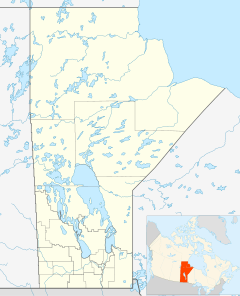Keeseekoowenin Ojibway First Nation facts for kids
Quick facts for kids
Keeseekoowenin 61
|
|||||||||||||||||||
|---|---|---|---|---|---|---|---|---|---|---|---|---|---|---|---|---|---|---|---|
| Indian Reserve 61 | |||||||||||||||||||
| Country | |||||||||||||||||||
| Province | |||||||||||||||||||
| Region | Westman | ||||||||||||||||||
| Area | |||||||||||||||||||
| • Land | 57.2 km2 (22.08 sq mi) | ||||||||||||||||||
| Population
(2016)
|
|||||||||||||||||||
| • Total | 386 | ||||||||||||||||||
| • Density | 17.5/km2 (45/sq mi) | ||||||||||||||||||
| Time zone | UTC-6 (Central (CST)) | ||||||||||||||||||
| • Summer (DST) | UTC-5 (Central (CDT)) | ||||||||||||||||||
|
|||||||||||||||||||
The Keeseekoowenin Ojibway First Nation (often called KOFN) is an Indigenous community. It is also known as the Riding Mountain Band. Their name in the Ojibwe language is Ojibwe: Giizhigowininiing.
This community mainly lives on a special area of land called Keeseekoowenin 61. This land is an Indian reserve, which is land set aside for First Nations people. It is located near Elphinstone, Manitoba, just south of Riding Mountain National Park.
The main reserve is surrounded by the Rural Municipality of Yellowhead. The KOFN also has two smaller reserve lands. One is called IR 61A, and it is inside Riding Mountain National Park, near Clear Lake. The other, IR 61B, is located between the two other reserves, by Bottle Lake.
Contents
History of the Keeseekoowenin Ojibway First Nation
The Keeseekoowenin Ojibway First Nation has a long history tied to their traditional lands.
Early Beginnings and Treaty 2
The main reserve land was first set up around a trading post called Riding Mountain House. This post was run by the Hudson's Bay Company, a very old trading company, from 1860 to 1895.
The Keeseekoowenin Ojibway people, also known as the Riding Mountain Band, signed an important agreement called Treaty 2. They signed this treaty with the Government of Canada on August 21, 1871. Treaties like this were agreements about land and rights between First Nations and the government.
The community gets its name from Keeseekoowenin. He was the Chief when the people moved to the reserve in 1875.
Relocation and Land Claims
In 1935, another Indigenous group, the Sovereign Okanase Indian Nation (also known as the Clear Water Lake Indian Tribe), had to move from their land. This land is now part of Riding Mountain National Park. They were relocated and joined the Keeseekoowenin Ojibway First Nation on their reserve, IR 61.
Later, in 1994, the Keeseekoowenin Ojibway First Nation reached a land claim settlement. This means they made an agreement to get back some of their traditional land. As part of this agreement, they were given the IR 61A reserve land, which is located right on the edge of the National Park.
Keeseekoowenin Reserve Lands
The Keeseekoowenin Ojibway First Nation has three separate pieces of reserve land.
- Keeseekoowenin 61 (IR 61A): This is the main reserve. It is located south of Riding Mountain National Park. It sits in a valley, and the Little Saskatchewan River flows through it.
- IR 61A (within the park): This second reserve is found inside Riding Mountain National Park. It is on the northwest shore of Clear Lake.
- Bottle Lake 61B: This third reserve is located between the other two reserve lands.


